-

新人教版高中英语必修2Unit 3 The Internet-Discovering Useful Structure教案一
This unit is about the Internet, which has a great influence to our humans and our lives. During the Listening & Speaking & Talking and Reading and Thinking section, the influence in examples has been shown. Thus, use the Present Perfect Tense is appropriate. However, in order to show the justice or weaken the doer of the behavior/action, it’s better to use the Present Perfect Passive Voice than the Present Perfect Tense. Besides, having learned to use the Present Perfect Passive Voice, students can beautify their language in their writing. 1. Learn the structure of the Present Perfect Passive Voice and its functions. 2. Learn to change the sentences with the Present Perfect Passive Voice into the sentences with the Present Perfect Passive Voice. 3. Learn to write sentences with the Present Perfect Passive Voice flexibly according to the context. 1. Learn the structure of the Present Perfect Passive Voice and its functions. 2. Learn to change the sentences with the Present Perfect Passive Voice into the sentences with the Present Perfect Passive Voice. 3. Learn to write sentences with the Present Perfect Passive Voice flexibly according to the context. Step 1 Observe the following sentences, then change the sentences into passive voice.He has been selected to take part in the sports meeting.(肯定句)他已被挑选出来参加运动会。The ink has not been removed from his overcoat.(否定句)墨迹还没有从他外套上去掉。

新人教版高中英语必修2Unit 3 The Internet-Reading and Thinking教案一
Paragraph 3. Jan decided to start an IT club to teach old people how to use computers and the Internet. Paragraph 4. Jan has started taking online classes to learn more about how to use the Internet to make society better. Paragraph 5. Jan’s life has been greatly improved by the Internet. Step 5: Critical thinking:(1)How do you arrange your time spent on study and the Internet? Is it reasonable? I usually surf the Internet using my mobile phone for only an hour after class, and it is reasonable for me.(2)What are your online activities? Are they safe? I chat with my friends, read news and play games. I never give away my private information so I think they are safe.Step 4: summary Much has been written about the wonders of the World Wide Web. There are countless articles (1)______(tell) us how the Internet has made our lives more convenient. But the Internet has done a lot (2)_____(much) for people than simply make life more convenient. People’s lives (3) _________________(change) by online communities and social networks so far. Take Jan for example, who developed a serious illness that made her (4)_____(stick) at home with only her computer to keep (5)___(she) company. She joined an online group (6)______ she could share problems, support and advice with others. She considered the ability to remove the distance between people as one of the greatest (7)_______(benefit). She was so inspired (8)____ she started an IT club in which many people have been helped. She has started to learn more about how to use the Internet to make society better. Her next goal is to start a charity website to raise money (9)___ children in poor countries. Jan’s life has been (10)______(great) improved by the Internet. Step 5 Homework:Review what we have learned and find out the key language points in the text.

新人教版高中英语必修2Unit 5 Music-Discovering Useful Structures教案一
Step1:自主探究。1.(教材P52)Born(bear) in the USA on 2 January 1970, Whitacre began studying music at the University of Nevada in 1988.2.(教材P52) Moved(move) by this music, he said, “It was like seeing color for the first time.”3.(教材P56)I was very afraid and I felt so alone and discouraged(discourage).4.(教材P58)Encouraged(encourage) by this first performance and the positive reaction of the audience, I have continued to play the piano and enjoy it more every day.Step2:语法要点精析。用法1:过去分词作表语1).过去分词可放在连系动词be, get, feel, remain, seem, look, become等之后作表语,表示主语所处的状态Tom was astonished to see a snake moving across the floor.汤姆很惊讶地看到一条蛇正爬过地板。Finally the baby felt tired of playing with those toys.终于婴儿厌倦了玩那些玩具。注意:1).过去分词作表语时与被动语态的区别过去分词作表语时,强调主语所处的状态;而动词的被动语态表示主语是动作的承受者,强调动作。The library is now closed.(状态)图书馆现在关闭了。The cup was broken by my little sister yesterday.(动作)昨天我妹妹把杯子打碎了。2)感觉类及物动词的现在分词与过去分词作表语的区别过去分词作表语多表示人自身的感受或事物自身的状态,常译作“感到……的”;现在分词多表示事物具有的特性,常译作“令人……的”。
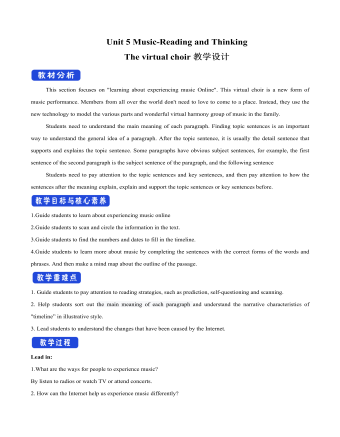
新人教版高中英语必修2Unit 5 Music-Reading and Thinking教案一
This section focuses on "learning about experiencing music Online". This virtual choir is a new form of music performance. Members from all over the world don't need to love to come to a place. Instead, they use the new technology to model the various parts and wonderful virtual harmony group of music in the family. Students need to understand the main meaning of each paragraph. Finding topic sentences is an important way to understand the general idea of a paragraph. After the topic sentence, it is usually the detail sentence that supports and explains the topic sentence. Some paragraphs have obvious subject sentences, for example, the first sentence of the second paragraph is the subject sentence of the paragraph, and the following sentenceStudents need to pay attention to the topic sentences and key sentences, and then pay attention to how the sentences after the meaning explain, explain and support the topic sentences or key sentences before.1.Guide students to learn about experiencing music online2.Guide students to scan and circle the information in the text.3.Guide students to find the numbers and dates to fill in the timeline.4.Guide students to learn more about music by completing the sentences with the correct forms of the words and phrases. And then make a mind map about the outline of the passage.1. Guide students to pay attention to reading strategies, such as prediction, self-questioning and scanning.2. Help students sort out the main meaning of each paragraph and understand the narrative characteristics of "timeline” in illustrative style.3. Lead students to understand the changes that have been caused by the Internet.

新人教版高中英语必修2Unit 5 Music-Reading For Writing教案一
(4)Now we have heard a number of outstanding speeches ... 我们已经聆听了许多精彩的发言……(5)Because we wanted the nations of the world, working together, to deal with ... 因为我们希望全世界各国团结起来去应对……(6)And if we do not act ... 如果我们不采取行动……(7)Now, I share the concerns that have been expressed ... 我也同意对于……表达的担心(8)Let us show the world that by working together we can ... 让我们告诉全世界,通过一起努力我们可以……(9)It is now time for us to ... 是时候我们……(10)And I have always wished that ... 我一直希望……(11)Thank you for letting me share this day with me.感谢你们和我共度这一天。实践演练:假如你是高中生李华,你校将举办一次以“音乐”为主题的演讲比赛,请你按照主题,写下你的演讲稿。注意:词数100左右。First of all, thank you for listening to my speech. My topic is: love music like love yourself.Music is like the air we need to maintain our normal lives around us. You can't imagine how terrible a world without music would be. Movies and TV shows have no music, only dry conversations and scenes; mobile phones only vibrations; streets only noisy crowds; cafes, western restaurants only depressed meals. What a terrible world it is!As a student, I hope we all can enjoy the fun brought by music in our spare time. Instead of just listening to music, we can even make our own music. Let's enjoy the fun of music!Thanks again for your attention!

新人教版高中英语必修3Unit 2 Morals and virtues教学设计一
(2) students are divided into groups according to the requirements of activity 3. Each student shares a story of personal experience or hearing-witnessing kindness, and then selects the most touching story in the group and shares it with the whole class. Before the students share the story, the teacher can instruct them to use the words and sentence patterns in the box to express. For example, the words in the box can be classified:Time order: first of all, then, after that, later, finally logical relationship :so, however, although, butTeachers can also appropriately add some transitional language to enrich students' expression:Afterwards, afterwards, at last, in the end, eventuallySpatial order: next to, far from, on the left, in front ofOtherwise, nevertheless, as a result, therefore, furthermore, in addition, as well asSummary: in a word, in short, on the whole, to sum up, in briefStep 8 Homework1. Understand the definition of "moral dilemma" and establish a correct moral view;2. Accumulate vocabulary about attitudes and emotions in listening texts and use them to express your own views;3. Complete relevant exercises in the guide plan.1、通过本节内容学习,学生能否理解理解“道德困境”的定义;2、通过本节内容学习,学生能否通过说话人所表达的内容、说话的语气、语调等来判断其态度和情绪;3、通过本节内容学习,学生能否针对具体的道德困境发表自己的看法和见解,能否掌握听力理训练中的听力策略。

新人教版高中英语必修2Unit 3 The Internet-Reading For Writing教案一
⑦identity theft 身份盗窃⑧chat room 聊天室⑨draft your blog post 起草博客帖子⑩post embarrassing photos 张贴尴尬照片 【话题句式】 1. How do you stay safe online and avoid bad experiences on the Internet? 你如何在网上保持安全, 避免在网上的不良经历? 2. I’m not an expert, but many years as a blogger have taught me a thing or two. 我不是专家, 但作为一个博主, 我已经学了好几年了。 3. If you see or read something that makes you feel uncomfortable, leave the site immediately. 如果你看到或读到一些让你觉得不舒服的东西, 立即离开这个网站。4. Don’t give out your address or phone number. 别告诉别人你的地址或电话号码。 5. Identity theft is a common and serious problem. 身份盗窃是一个常见而严重的问题。6. Being online is no excuse for being rude, and you don’t want to become a target for a troll or cyberbully. 上网并不是无礼的借口, 你也不想成为发挑衅帖子的人或网络恶霸的目标。 7. Trolls often use several false names so that they can stay on a site. 发挑衅帖子的人经常使用几个假名, 这样他们就可以留在一个网站上。8. However, the more polite you are, the less likely it is you will be attacked. 然而, 你越有礼貌, 你被攻击的可能性就越小。

新人教版高中英语必修3Unit 1 Festivals and Celebrations教学设计一
本板块的活动主题是“谈论节日活动”(Talk about festival activities),主要是从贴近学生日常生活的角度来切入“节日”主题。学生会听到发生在三个国家不同节日场景下的简短对话,对话中的人们正在参与或将要亲历不同的庆祝活动。随着全球化的进程加速,国际交流日益频繁,无论是国人走出国门还是外国友人访问中国,都已成为司空见惯的事情。因此,该板块所选取的三个典型节日场景都是属于跨文化交际语境,不仅每组对话中的人物来自不同的文化背景,对话者的身份和关系也不尽相同。1. Master the new words related to holiday: the lantern, Carnival, costume, dress(sb)up, march, congratulation, congratulate, riddle, ceremony, samba, make - up, after all. 2. To understand the origin of major world festivals and the activities held to celebrate them and the significance of these activities;3. Improve listening comprehension and oral expression of the topic by listening and talking about traditional festivals around the world;4. Improve my understanding of the topic by watching pictures and videos about different traditional festivals around the world;5. Review the common assimilation phenomenon in English phonetics, can distinguish the assimilated phonemes in the natural language flow, and consciously use the assimilation skill in oral expression. Importance:1. Guide students to pay attention to the attitude of the speaker in the process of listening, and identify the relationship between the characters;2. Inspire students to use topic words to describe the festival activities based on their background knowledge. Difficulties:In the process of listening to the correct understanding of the speaker's attitude, accurately identify the relationship between the characters.

新人教版高中英语必修3Unit 3 Diverse Cultures教学设计一
Activity 81.Grasp the main idea of the listening.Listen to the tape and answer the following questions:Who are the two speakers in the listening? What is their relationship?What is the main idea of the first part of the listening? How about the second part?2.Complete the passage.Ask the students to quickly review the summaries of the two listening materials in activity 2. Then play the recording for the second time.Ask them to complete the passage and fill in the blanks.3.Play the recording again and ask the students to use the structure diagram to comb the information structure in the listening.(While listening, take notes. Capture key information quickly and accurately.)Step 8 Talking Activity 91.Focus on the listening text.Listen to the students and listen to the tape. Let them understand the attitudes of Wu Yue and Justin in the conversation.How does Wu Yue feel about Chinese minority cultures?What does Justin think of the Miao and Dong cultures?How do you know that?2.learn functional items that express concerns.Ask students to focus on the expressions listed in activity. 3.And try to analyze the meaning they convey, including praise (Super!).Agree (Exactly!)"(You're kidding.!)Tell me more about it. Tell me more about it.For example, "Yeah Sure." "Definitely!" "Certainly!" "No kidding!" "No wonder!" and so on.4.Ask the students to have conversations in small groups, acting as Jsim and his friends.Justin shares his travels in Guizhou with friends and his thoughts;Justin's friends should give appropriate feedback, express their interest in relevant information, and ask for information when necessary.In order to enrich the dialogue, teachers can expand and supplement the introduction of Miao, dong, Lusheng and Dong Dage.After the group practice, the teacher can choose several groups of students to show, and let the rest of the students listen carefully, after listening to the best performance of the group, and give at least two reasons.
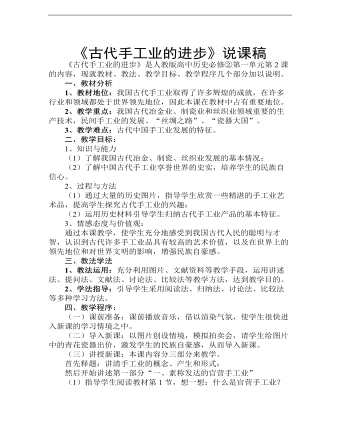
高中历史人教版必修二《第2课古代手工业的进步》说课稿
二、教学目标:1、知识与能力(1)了解我国古代冶金、制瓷、丝织业发展的基本情况;(2)了解中国古代手工业享誉世界的史实,培养学生的民族自信心。2、过程与方法(1)通过大量的历史图片,指导学生欣赏一些精湛的手工业艺术品,提高学生探究古代手工业的兴趣;(2)运用历史材料引导学生归纳古代手工业产品的基本特征。3、情感态度与价值观:通过本课教学,使学生充分地感受到我国古代人民的聪明与才智,认识到古代许多手工业品具有较高的艺术价值,以及在世界上的领先地位和对世界文明的影响,增强民族自豪感。
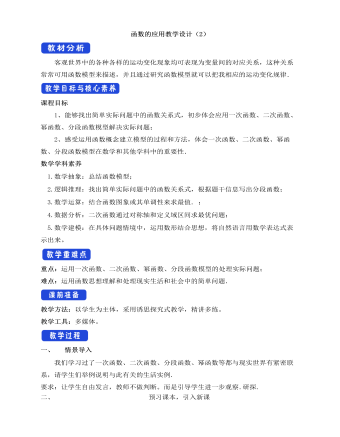
人教A版高中数学必修一函数的应用(一)教学设计(2)
客观世界中的各种各样的运动变化现象均可表现为变量间的对应关系,这种关系常常可用函数模型来描述,并且通过研究函数模型就可以把我相应的运动变化规律.课程目标1、能够找出简单实际问题中的函数关系式,初步体会应用一次函数、二次函数、幂函数、分段函数模型解决实际问题; 2、感受运用函数概念建立模型的过程和方法,体会一次函数、二次函数、幂函数、分段函数模型在数学和其他学科中的重要性. 数学学科素养1.数学抽象:总结函数模型; 2.逻辑推理:找出简单实际问题中的函数关系式,根据题干信息写出分段函数; 3.数学运算:结合函数图象或其单调性来求最值. ; 4.数据分析:二次函数通过对称轴和定义域区间求最优问题; 5.数学建模:在具体问题情境中,运用数形结合思想,将自然语言用数学表达式表示出来。 重点:运用一次函数、二次函数、幂函数、分段函数模型的处理实际问题;难点:运用函数思想理解和处理现实生活和社会中的简单问题.
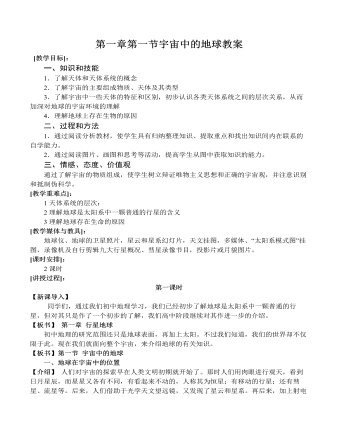
人教版高中地理必修1第一章第一节宇宙中的地球教案
【总结讲解】地球为生命物质的存在提供了三个最优越的条件,这也是其它行星不具备的条件——(1)日地距离适中(1.496亿km),使地表平均气温为15℃,有利于生命过程的发生和发展;地球上的温度,还有利于水的液态存在。适合生物呼吸的大气: (2) 地球的体积、质量适中,吸引大量气体聚集在地球周围,又经过漫长的演化,形成了以氮、氧为主的适合生物呼吸的大气。(3)海洋的形成: 由于地球内部放射性元素衰变致热和原始地球重力收缩及地球内部的物质运动等形成了原始大洋,地球最初的单细胞生命就出现在大洋中。(备注:此部分可以模拟演示或讲解地球存在生命的温度、大气、水等条件;假设地球温度过高或过低对地球生命的影响;引导学生分析地球大气、温度与地球水的关系)【板书】1、日地距离适中2、地球的体积、质量适中3、液态水的存在【启发提问】 宇宙中是否只有地球上存在有生命物质?
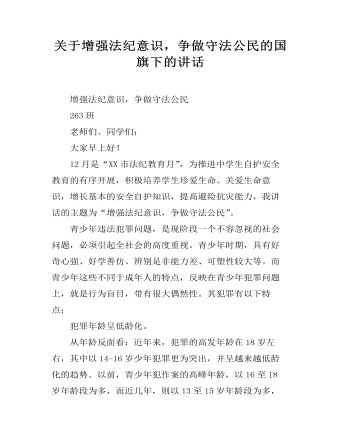
关于增强法纪意识,争做守法公民的国旗下的讲话
增强法纪意识,争做守法公民263班老师们、同学们:大家早上好!12月是“XX市法纪教育月”,为推进中学生自护安全教育的有序开展,积极培养学生珍爱生命、关爱生命意识,增长基本的安全自护知识,提高避险抗灾能力,我讲话的主题为“增强法纪意识,争做守法公民”。青少年违法犯罪问题,是现阶段一个不容忽视的社会问题,必须引起全社会的高度重视。青少年时期,具有好奇心强、好学善仿、辨别是非能力差、可塑性较大等。而青少年这些不同于成年人的特点,反映在青少年犯罪问题上,就是行为盲目,带有很大偶然性。其犯罪有以下特点:犯罪年龄呈低龄化。从年龄反面看:近年来,犯罪的高发年龄在18岁左右,其中以14-16岁少年犯罪更为突出,并呈越来越低龄化的趋势。
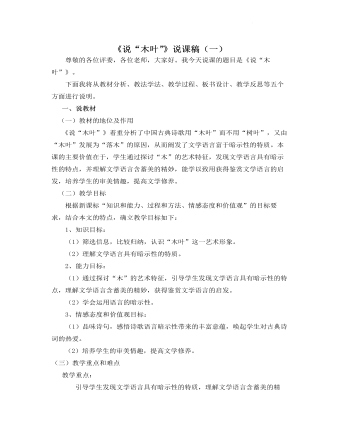
《说“木叶”》说课稿(一) 2021-2022学年统编版高中语文必修下册
这五个问题,主要从学情出发,由浅入深,从感知到理论,培养学生的鉴赏能力。第三环节:延伸探究、展示成果(多媒体显示)走出文本,引入课外同类文学现象,让学生能够触类旁通,举一反三,把教材作为一个例子,让学生在深入的文学鉴赏中再次获得语言的审美。同学们初步掌握了文学语言具有暗示性的性质后,还需巩固、提升鉴赏能力!这里我采取的方法是:引导学生认真阅读文本,经小组合作探究后,得出本组的鉴赏成果并加以展示,这里重在培养学生的理解能力和分析综合能力。问题是:1、 请结合下面三首词的意境,选用残红、落红、乱红填空。2、 阅读下面这些句子,理解“燕”在词语中的暗示意义。该环节充分体现了 “ 教师为主导,学生为主体”的原则。老师的适时点拨,让学生的鉴赏思路更加清晰。学生通过合作探究,理解能力和分析综合能力得到了提升。
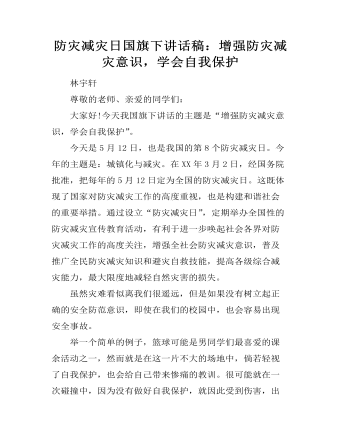
防灾减灾日国旗下讲话稿:增强防灾减灾意识,学会自我保护
林宇轩尊敬的老师、亲爱的同学们:大家好!今天我国旗下讲话的主题是“增强防灾减灾意识,学会自我保护”。今天是5月12日,也是我国的第8个防灾减灾日。今年的主题是:城镇化与减灾。在XX年3月2日,经国务院批准,把每年的5月12日定为全国的防灾减灾日。这既体现了国家对防灾减灾工作的高度重视,也是构建和谐社会的重要举措。通过设立“防灾减灾日”,定期举办全国性的防灾减灾宣传教育活动,有利于进一步唤起社会各界对防灾减灾工作的高度关注,增强全社会防灾减灾意识,普及推广全民防灾减灾知识和避灾自救技能,提高各级综合减灾能力,最大限度地减轻自然灾害的损失。虽然灾难看似离我们很遥远,但是如果没有树立起正确的安全防范意识,即使在我们的校园中,也会容易出现安全事故。举一个简单的例子,篮球可能是男同学们最喜爱的课余活动之一,然而就是在这一片不大的场地中,倘若轻视了自我保护,也会给自己带来惨痛的教训。很可能就在一次碰撞中,因为没有做好自我保护,就因此受到伤害,出现骨折等现象。因此,上体育课、体锻课前要做好准备活动,运动时注意不要剧烈碰撞,以免撞伤或摔伤;活动时,要在体育老师的正确指导下,使用体育器材或参加运动,课余时间活动要注意安全。
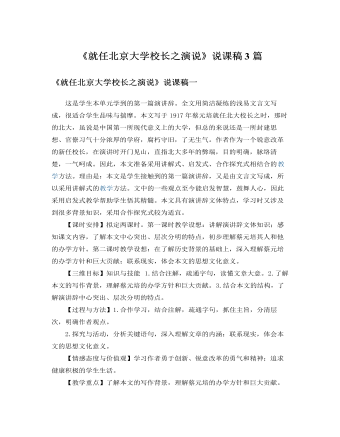
人教版高中语文必修2《就任北京大学校长之演说》说课稿3篇
(三)教学重、难点1、教学重点:结合课文,了解演讲辞针对性强、条理清楚、通俗易懂、适当的感情色彩等特点。2、教学难点:深入理解文章内涵,联系现实,体会本文的现实意义二、说学情高中学生在初中阶段已经接触过演讲辞了,对演讲词的特点已经有了一些基本的知识,因此本轮的教学应该让他们在此基础上有所提高。本文是学生在高中阶段第一次接触演讲辞,有必要让他们了解演讲辞的特点及课文如何体现这些特点的。随着年龄的增长,生活阅历的增加,高中学生正逐渐形成自己对世界、对人生的看法,蔡元培先生的这篇文章能很好地激发他们对当前的高中学习和未来的大学生活进行思考。此外,学生对北大的历史及蔡元培先生作这番演讲的时代背景了解不深,应作出补充说明。

人教A版高中数学必修一三角函数的应用教学设计(2)
本节课是在学习了三角函数图象和性质的前提下来学习三角函数模型的简单应用,进一步突出函数来源于生活应用于生活的思想,让学生体验一些具有周期性变化规律的实际问题的数学“建模”思想,从而培养学生的创新精神和实践能力.课程目标1.了解三角函数是描述周期变化现象的重要函数模型,并会用三角函数模型解决一些简单的实际问题.2.实际问题抽象为三角函数模型. 数学学科素养1.逻辑抽象:实际问题抽象为三角函数模型问题;2.数据分析:分析、整理、利用信息,从实际问题中抽取基本的数学关系来建立数学模型; 3.数学运算:实际问题求解; 4.数学建模:体验一些具有周期性变化规律的实际问题的数学建模思想,提高学生的建模、分析问题、数形结合、抽象概括等能力.

人教A版高中数学必修一函数模型的应用教学设计(2)
本节通过一些函数模型的实例,让学生感受建立函数模型的过程和方法,体会函数在数学和其他学科中的广泛应用,进一步认识到函数是描述客观世界变化规律的基本数学模型,能初步运用函数思想解决一些生活中的简单问题。课程目标1.能利用已知函数模型求解实际问题.2.能自建确定性函数模型解决实际问题.数学学科素养1.数学抽象:建立函数模型,把实际应用问题转化为数学问题;2.逻辑推理:通过数据分析,确定合适的函数模型;3.数学运算:解答数学问题,求得结果;4.数据分析:把数学结果转译成具体问题的结论,做出解答;5.数学建模:借助函数模型,利用函数的思想解决现实生活中的实际问题.重点:利用函数模型解决实际问题;难点:数模型的构造与对数据的处理.
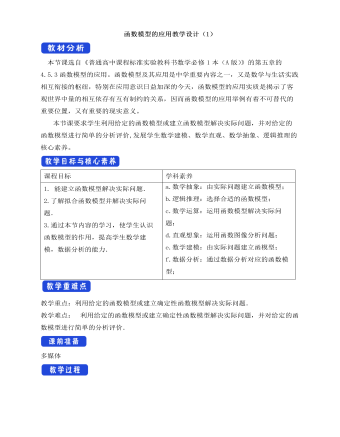
人教A版高中数学必修一函数模型的应用教学设计(1)
本节课选自《普通高中课程标准实验教科书数学必修1本(A版)》的第五章的4.5.3函数模型的应用。函数模型及其应用是中学重要内容之一,又是数学与生活实践相互衔接的枢纽,特别在应用意识日益加深的今天,函数模型的应用实质是揭示了客观世界中量的相互依存有互有制约的关系,因而函数模型的应用举例有着不可替代的重要位置,又有重要的现实意义。本节课要求学生利用给定的函数模型或建立函数模型解决实际问题,并对给定的函数模型进行简单的分析评价,发展学生数学建模、数学直观、数学抽象、逻辑推理的核心素养。1. 能建立函数模型解决实际问题.2.了解拟合函数模型并解决实际问题.3.通过本节内容的学习,使学生认识函数模型的作用,提高学生数学建模,数据分析的能力. a.数学抽象:由实际问题建立函数模型;b.逻辑推理:选择合适的函数模型;c.数学运算:运用函数模型解决实际问题;
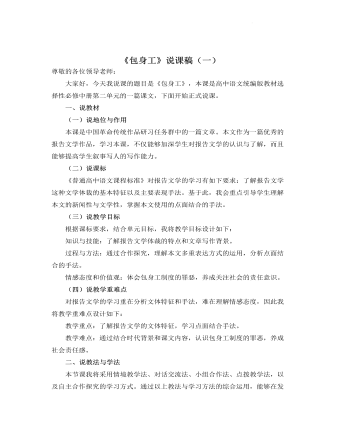
《包身工》说课稿(一) 2021-2022学年统编版高中语文选择性必修中册
首先请同学设想:“如果你是作者,当你准备写一篇以包身工为题材的文章时,会从哪些方面选材?”而“本文又是如何将这些材料组织起来的?”这一环节能够使学生参与到教学过程中来,通过问题能够引导学生关注本文的选材类型和表达方式,区分文中穿插的感性、理性材料,从而理解报告文学兼文学性、议论性于一体的文学特质。然后请同学阅读表现包身工起床情形的场面描写(1-6段),并引导学生分析该段表达效果;再请同学们阅读“芦柴棒”被虐待段(16-20段),并引导同学们比较两个片段在选材上有何区别,进而归纳点面结合的手法的艺术效果。最后请学生找出文中其他运用点面结合手法的段落,并尝试自主分析。这一环节能够引导学生直观地感受本文场面描写的作用,并分析点面结合手法的艺术效果,同时也让学生通过练习探究掌握分析该手法的方法。